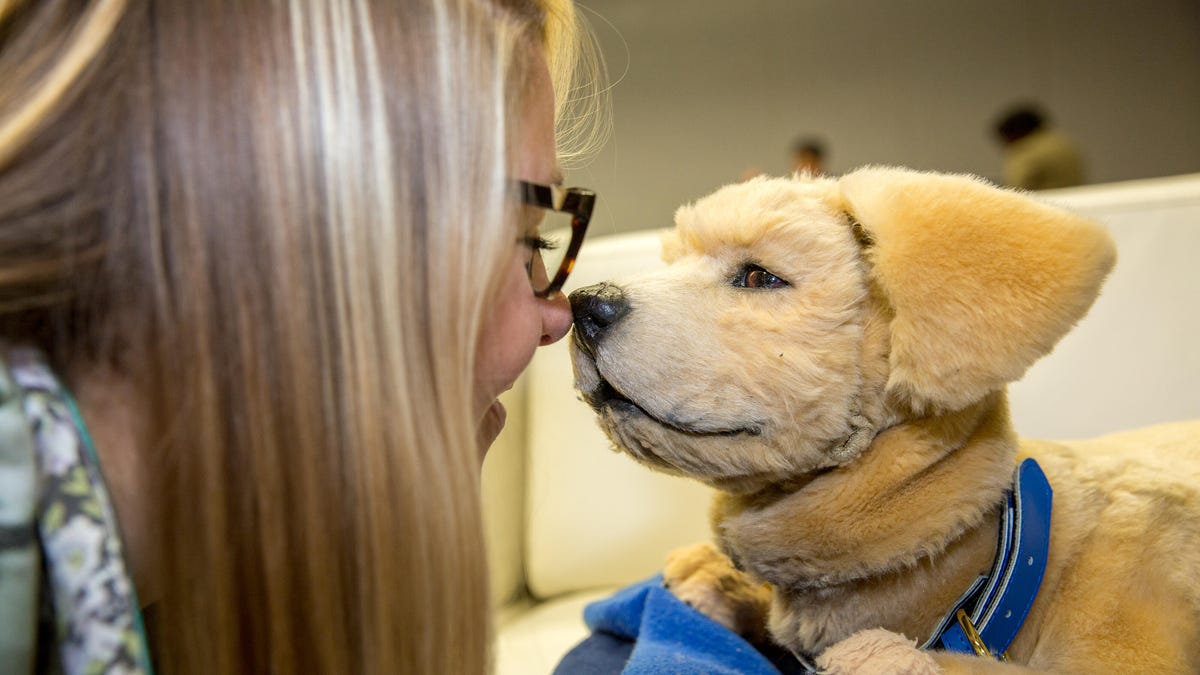A snoring robot Labrador puppy stole my whole heart at CES 2020
Tombot's animatronic dog Jennie is designed for seniors but loved by all.

Jennie and I -- now total besties.
It's love at first sight. The small golden Labrador curled up on the corner of the stage tilts her head and waggles her ears. The Lab's name is Jennie, and she's a dog who also happens to be a robot.
In my heart of hearts, I'm fully aware that Jennie isn't real, and yet I'm drawn to her just as I'm drawn to real dogs whenever I pass one on the street. I've come to this talk at CES in Las Vegas because I saw a picture of Jennie on the internet and knew she would be here.
Jennie is the creation of Tom Stevens, founder and CEO of robotics startup Tombot, and she was made in collaboration with the Jim Henson Company. Stevens was inspired to make a realistic robotic lab when his mother was diagnosed with Alzheimer's disease and had her dog taken away.
"My mom's story isn't unique," he says speaking during the CES conference on Tuesday. Seniors with dementia derive a great deal of comfort from their pets, he adds, but as the disease progresses they often become increasingly unable to care for them.
As Stevens is talking, Jennie calms down and drifts off to sleep. When she starts snoring, I let out an audible "ahhh." I can't wait to get close to her, and I'm not the only one.
Jennie responds to being stroked and petted.
With CES in full swing, most people you encounter roaming the halls of the Las Vegas Convention Center are bleary-eyed and listless. Only the rare exhibit incites enough interest for a crowd to form and pull their phones out to film or take photos. Rarer still is the kind of genuine excitement that causes eyes to light up and broad smiles to appear on people's faces.
In Jennie, I've found one of those rare exceptions. As we try to find a quiet spot to photograph Jennie and capture her moves on video, Stevens warns me that it might be hard -- wherever Jennie goes, people come over to see her, he says.
He throws a cloth over her while we move her to a better location, but once he uncovers her again, it's like moths to a flame. Stevens, looking on like a proud father, is happy for Jennie to have all the attention in the world. He steps back to give people space to interact with her and answers all questions with a grin on his face.
"What's the company responsible for this dog?" demands one man. "Can I pet her?" a woman inquires. "Where can I buy one of these? How much?" says another. "My daughter would love this."
He tells her that Jennie is available for preorder and costs $449 (about £345 or AU$655), but if she joins the waitlist she can buy one for just $399. Jennie's not really built to be a toy for children -- she's primarily designed for people like Stevens' mother -- but it's easy to see why people would want her regardless of her purpose. Tombot has already received orders from parents of children with autism and people with PTSD.
Under Jennie's synthetic fur are around 50 sensors that can feel how softly or vigorously you're interacting with her. When she feels your touch or hears you give her a command through her in-built microphones, she'll respond accordingly. If you pat her gently, she might move her head, but if you give her more fuss, she'll get more excited and wag her tail. Jennie has 10 in-built motors controlling her movements. Seven of them are in her face, giving her the ability to move her ears, eyebrows and nose to mimic the expressions of a real-life dog.
Jennie's tail in motion.
Stevens has designed Jennie to strictly be a lap dog -- to sit on someone's knee or the arm of their chair. He didn't want to make her mobile, he explains, as seniors with dementia are liable to trip and he doesn't want her put on the floor as a tripping hazard.
But other than running around, she should be able to do everything a lap dog would do. "Jennie, speak!" Stevens says, and she barks in response. She'll also be able to whine, yip and howl and respond to a range of the other commands by the time she ships. She'll stop short of farting, though, he adds. Once Jennie ships, software updates will be available over the air via the companion app.
When I finally get close to Jennie, I'm amazed at how willing I am to suspend my disbelief and sit petting her on my lap in front of a room full of onlookers. I think of the "no dogs" clause in the tenancy agreement for my London flat and wonder how Jennie would fit in with my boyfriend and (nonrobotic) cat.
"We're not trying to replace anything, but we are trying to fill a void," Stevens says of the role Jennie is designed to play in people's lives. Perhaps there isn't a single cookie-cutter ideal customer for something like a robotic dog, but there are plenty who might find a Jennie to be just what they need.

